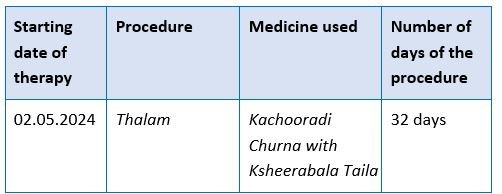Ayurvedic approach in Drug Induced Insomnia - A Case Study
DOI:
https://doi.org/10.21760/jaims.9.7.56Keywords:
Anidra, Padabyanga, Hapushadi Yapana Vasti, Insomnia, sleeplessnessAbstract
Ayurveda is a life science which proclaims the importance of daily necessities like food, sleep, exercise for a healthy life. Sleep or Nidra is considered as one among the sub pillars of life (Thrayopasthamba). Nidranasa or Anidra is a state of sleeplessness which is an effect of increased Vatadosha. The potential cause of this sleeplessness can be anything like an adverse effect of certain drugs as in this case. In this case study, the patient was having a migraine headache and was under medication continuously for 120 days. After this he gradually developed sleeplessness and he was contracted to a person who was having a sleeping hours of two, even after taking sleeping pills. This shattered his physical as well as mental condition. Ayurvedic treatments planned for this was an integrated approach including internal medicine, external therapies and maintaining suitable environment for his condition. External therapies like Padabyanga, Shirodhara, Hapushadi Yapana Vasti gave a considerable relief. The Insomnia severity index score was 24 while admission and was reduced to 13 after treatments. Safe, effective, systematic approach without any adverse effects gave improvement in quality of life of the patient.
Downloads
References
T Sreekumar. Annarakshadhyaya. Ashtangahridayam suthrasthanam. Thrissur: Harisree publications; 2017. 201
Shashirekha H.K, Bargale Sushant Sukumar. Ashtaunindithiya adhyayam. Charaka samhitha soothrasthanam. New Delhi: Chaukamba publications; 2017. 346
Shashirekha H.K, Bargale Sushant Sukumar. Ashtaunindithiya adhyayam. Charaka samhitha soothrasthanam. New Delhi: Chaukamba publications; 2017. 351
Shashirekha H.K, Bargale Sushant Sukumar. Ashtaunindithiya adhyayam. Charaka samhitha soothrasthanam. New Delhi: Chaukamba publications; 2017. 350
Niraj Ahuja. Sleep disorders. A short textbook of psychiatry. New Delhi: Jaypee publications; 2011. 136
Goadsby PJ. Pathophysiology of migraine. Ann Indian Acad Neurol. 2012 Aug;15(Suppl 1): S15-22. doi: 10.4103/0972-2327.99993. PMID: 23024559; PMCID: PMC3444225.
Morin CM, Belleville G, Bélanger L, Ivers H. The Insomnia Severity Index: psychometric indicators to detect insomnia cases and evaluate treatment response. Sleep. 2011 May 1;34(5):601-8. doi: 10.1093/sleep/34.5.601. PMID: 21532953; PMCID: PMC3079939.
Bastien CH, Vallières A, Morin CM. Validation of the Insomnia Severity Index as an outcome measure for insomnia research. Sleep Med. 2001 Jul;2(4):297-307. doi: 10.1016/s1389-9457(00)00065-4. PMID: 11438246.
Govind Das Sen. Pramehaki chikitsa. Baishajyaratnvali. Bombay: Shri Venkateswara steam press; 2009. 879
K V Krishnan vaidyan and S Gopala Pillai. Manasamithram vatakam. Sahasrayogam. Alappuzha: Vidyarambham publishers; 2011. 139
Prof. K. R. Srikantha Murthy. Rasayanavidhiradhyaya. Ashtanga hridayam uttarasthabam. Varanasi: Chowkhamba Krishnadas Academy; 2019. 388
Balkrishna A, Thakur P, Varshney A. Phytochemical Profile, Pharmacological Attributes and Medicinal Properties of Convolvulus prostratus - A Cognitive Enhancer Herb for the Management of Neurodegenerative Etiologies. Front Pharmacol. 2020 Mar 3;11:171. doi: 10.3389/fphar.2020.00171. PMID: 32194410; PMCID: PMC7063970.
Siddiqui NA, Ahmad N, Musthaq N, Chattopadhyaya I, Kumria R, Gupta S. Neuropharmacological Profile of Extracts of Aerial Parts of Convolvulus pluricaulis Choisy in Mice Model. Open Neurol J. 2011 Jul 11;8:11-4. doi: 10.2174/1874205X01408010011. PMID: 25110532; PMCID: PMC4126185.
Shashirekha H.K, Bargale Sushant Sukumar. Aragwadiya adhyaya. Charaka samhitha soothrasthanam. New Delhi: Chaukamba publications; 2017. 57
Acharya YT. Sushruta Samhita of Sushruta. Reprint ed. Varanasi: Choukhamba Surabharati Prakashana Publications; 2008. 778.
K V Krishnan vaidyan and S Gopala Pillai. Ksheerabala taila. Sahasrayogam. Alappuzha: Vidyarambham publishers; 2011. 315
Angadi, Sunanda & Katti, Anand & Aruna,. (2015). Effect of Jatamansi Taila Nasya and Kshiradhara in Insomnia. 11.
T Sreekumar. Gandushadividhiradhyaya. Ashtanga hridayam suthrasthanam. Thrissur: Harisree publications; 2017. 130
Uebaba K, Xu FH, Tagawa M, Asakura R, Itou T, Tatsuse T, Taguchi Y, Ogawa H, Shimabayashi M, Hisajima T. Using a healing robot for the scientific study of shirodhara. Altered states of consciousness and decreased anxiety through Indian dripping oil treatments. IEEE Eng Med Biol Mag. 2005 Mar-Apr;24(2):69-78. doi: 10.1109/memb.2005.1411351. PMID: 15825848.
K V Krishnan vaidyan and S Gopala Pillai. Chandanadi taila. Sahasrayogam. Alappuzha: Vidyarambham publishers; 2011. 218
G. Shrinivasa Acharya. Siroabyanga. Panchakarma illustrated. Delhi: Chaukamba Sanskrit pratishthan; 2006. 76
Shashirekha H.K, Bargale Sushant Sukumar. Uttarabasti sidhi adhyayam. Charaka samhitha sidhisthanam. New Delhi: Chaukamba publications; 2018. 327-328
K. R. Srikantha Murthy. Kushtachikitsa. Ashtanga hridayam chikitsasthanam. Varanasi: Chowkhamba Krishnadas Academy; 2019. 472-473
G. Shrinivasa Acharya. Padabyanga. Panchakarma illustrated. Delhi: Chaukamba Sanskrit pratishthan; 2006. 125
P.M. Govindan Vaidyan & Cheppatt K. Achuthavariyar. Garbhavyapath. Ashtanga hridayam Shareerasthanam. Kodungallur: Devi book stall; 2018. 63-64
Akshay B Hiremath, Gurubasavaraj Yalagachin, K K Resmi, T S Uday, H N Chaithra, N K Ashitha, A clinical study on combined effect of Padabhyanga and Pranayama in Nidranasha (Primary Insomnia) - Research Article. J Ayu Int Med Sci. 2022;7(5):1-5















